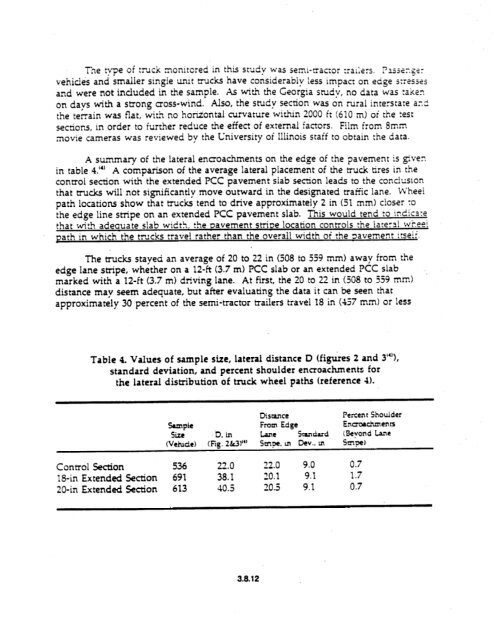chapter 3 rigid pavement - DOT On-Line Publications - Department ...
chapter 3 rigid pavement - DOT On-Line Publications - Department ...
chapter 3 rigid pavement - DOT On-Line Publications - Department ...
Create successful ePaper yourself
Turn your PDF publications into a flip-book with our unique Google optimized e-Paper software.
The type of trdck monitored in this study was semi-nac;or :rai;ers. p~s~e~.~o:<br />
vehicles and smaller single unit treks have considerably less impacr on edge S;ressej<br />
and were not induded in the sample. AS with the Georgia study, no data was taken<br />
on days with a strong cross-wind. Also, the study section was on rural interstate anti<br />
the terrain was fiat;with no hotiontal curvature within 2000 ft (610 m) of the test<br />
sections, in order to further reduce the effect of external factors. Film from 8mm<br />
movie cameras was reviewed by the University of Iilinois staff to obtain the data.<br />
A summary of the lateral encroachments on the edge of the <strong>pavement</strong> is given<br />
in table 4.“’ A comparison of the average lateral placement of the truck tires in the<br />
control section with the extended PCC <strong>pavement</strong> slab section leads to the concicsion<br />
that trucks will not significantly move outward in the designated traffic lane. Ct’heel<br />
path locations show that trucks tend to drive approximately 2 in (51 mm) closer to<br />
the edge line stripe on an extended PCC <strong>pavement</strong> slab. This would tend to ir.dica:e<br />
that with adeauate slab widt.,. b the oavement striue location controls the lareral wkeei<br />
path in which the trucks travel rather than the overall width of the gavemerrt itself.<br />
The trucks stayed an average of 20 to 22 in (508 to 359 mm) away from the<br />
edge Iane stripe, whether on a 12-ft (3.7 m) PCC slab or an extended PCC slab<br />
marked with a 12-ft (3.7 m) driving lane. At first, the 20 to 22 in (508 to 339 mm)<br />
distance may seem adequate, but after evaluating the data it can be seen that<br />
approximately 30 percent of the semi-tractor trailers travel 18 in (457 mm) or less<br />
Table 4. Values of sample size, lateral distance D (fig&es 2 and 3”‘),<br />
standard deviation, and percent shoulder encroachments for<br />
the lateral distribution of truck wheel paths (reference 4).<br />
Distance<br />
Percent Shoulder<br />
Sunpk From Edge Erraoachmencs<br />
size ‘D, in lane Standard (Beyond Lane<br />
Wehide) (Fig. t&3)” smpe, ul Dev.. VI Smpe)<br />
Control Section 536 22.0 22.0 9.0 0.7<br />
18-in Extended Section 691 38.1 20.1 9.1 1.7<br />
to-in Extended Section 613 40.5 20.3 9.1 0.7<br />
3.8.12
















